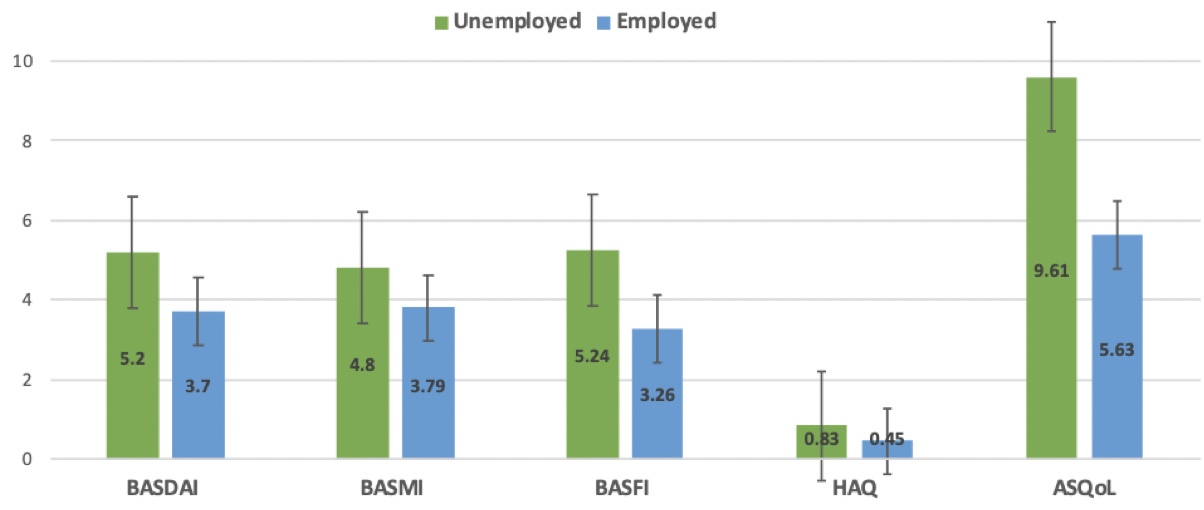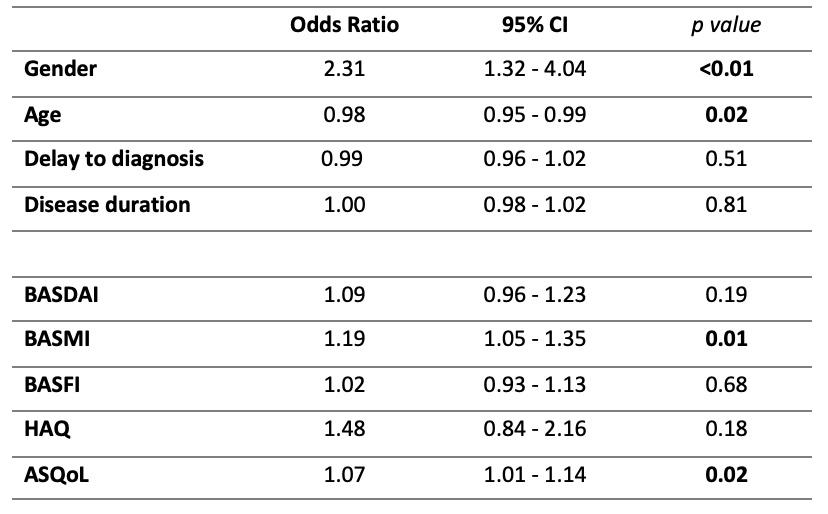Session Information
Session Type: Poster Session A
Session Time: 8:30AM-10:30AM
Background/Purpose: Axial spondyloarthropathy (axSpA) is an inflammatory arthritis of the axial skeleton. Persistent disease activity can result in significant disability and affect ability to maintain employment. The Ankylosing Spondylitis Registry of Ireland (ASRI) is a source of epidemiological data on axSpA in Ireland. The aim of this study was to examine the prevalence of unemployment in axSpA and quantify the impact on burden of disease, level of function and quality of life.
Methods: For the purposes of this analysis data was extracted from the ASRI on participants with employment data recorded. Patients were analysed on the basis of employment and categorised as employed or unemployed. A two tailed t-test was used to test for statistical significance in mean continuous variables between groups. For categorical variables, an independent chi-squared test of independence determined statistical significance. An alpha level of p< 0.05 was deemed significant. IBM SPSS v.26 was used for data and statistical analysis.
Results: Employment status was available for 876 patients enrolled in the ASRI. Overall 21.6% (189) of the population was unemployed, which is considerably higher than national averages of 6.2-13.1% during the same period. In addition, 24% (213) reported axSpA as a limitation in work ability. Unemployed patients reported significantly worse BASDAI (5.2 vs 3.7, p< 0.01), BASMI (4.8 vs 3.79, p< 0.01), BASFI (5.24 vs 3.26, p< 0.01), HAQ (0.83 vs 0.45, p< 0.01), and ASQoL scores (9.61 vs 5.63, p< 0.01) compared to employed axSpA patients(figure 1). A higher proportion of males were unemployed as compared to females (table 1). No significant differences were noted in pattern of disease, medication usage or baseline demographics. Male sex (OR 2.31, 95% CI 1.32-4.04), worse BASMI (OR 1.19, 95% CI 1.05-1.35) and worse ASQoL scores (OR 1.07, 95% CI 1.01-1.14) were found to be significant predictors of unemployment (table 2).
Conclusion: Prevalence of unemployment in axSpA is notably higher than nationally reported averages from the general population. Despite a high uptake of biologic therapy in this group, these patients have higher levels of disease activity, poorer levels of function and worse quality of life compared to employed axSpA patients. Predictors of unemployment were male sex, worse spinal mobility and poorer quality of life. In males, higher average BASMI scores were a significant contributing factor to the higher rates of unemployment observed. Prompt intervention for patients with worsening outcome measures, in particular spinal restriction, would provide an opportunity for occupational supports and prevent progression to unemployment.
To cite this abstract in AMA style:
Maguire S, Fiona W, Gallagher P, O'Shea F. Identifying Predictors of Unemployment in Axial Spondyloarthropathy: Data from the Ankylosing Spondylitis Registry of Ireland [abstract]. Arthritis Rheumatol. 2021; 73 (suppl 9). https://acrabstracts.org/abstract/identifying-predictors-of-unemployment-in-axial-spondyloarthropathy-data-from-the-ankylosing-spondylitis-registry-of-ireland/. Accessed .« Back to ACR Convergence 2021
ACR Meeting Abstracts - https://acrabstracts.org/abstract/identifying-predictors-of-unemployment-in-axial-spondyloarthropathy-data-from-the-ankylosing-spondylitis-registry-of-ireland/



